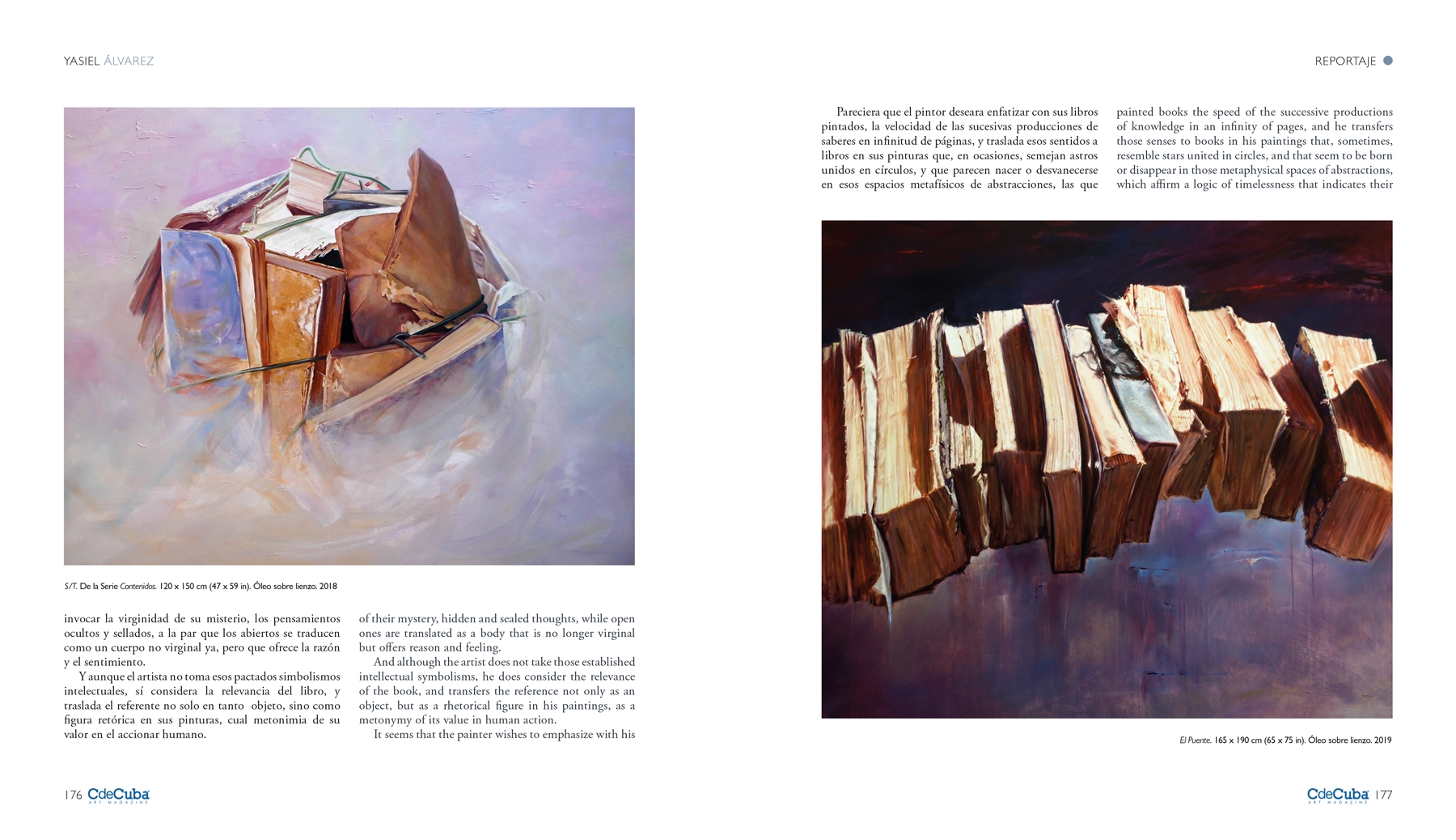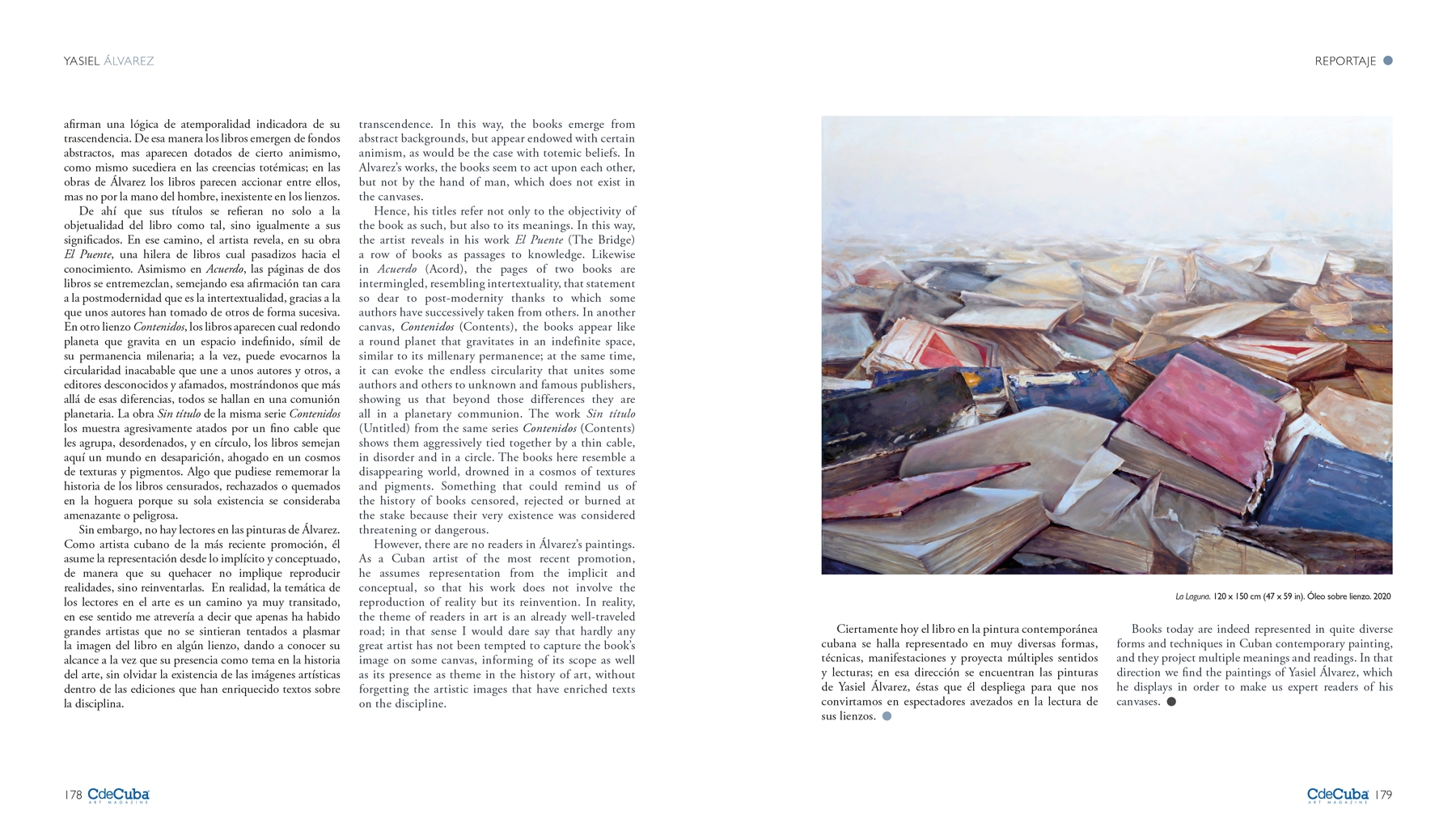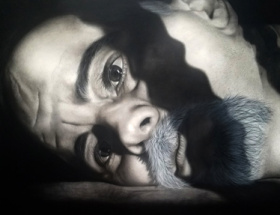Books in Art: Revelations by Yasiel Álvarez
By Carina Pino Santos
Packed books, open in a circle, tied with a suffocating cable, barely sealed by a strip like badly bandaged wounds, appear in the works of the painter Yasiel Álvarez, who turns this object into the protagonist of his Contents Series.
Paintings in which the artistic search is centered on the books that represent not only that physical object that usually accompanies us, but also their functions as transmitters of ideological, aesthetic or symbolic values.
It is precisely this destiny of sustenance for the cultures of the world that has nourished our identity for centuries, from the stone where they were carved to the most modern support of digital screens, what encourages the young artist. That is why he tells us: “I am motivated every day by the thirst for knowledge and our ever-changing society, so my work aims to dialogue with time and experience.”
The book, as we know, has been until today a fundamental axis for the development of culture and memory. In this way, the book’s theme forms an extensive trail, during which the modes of transmission of knowledge changed. And so much so that we can also read our evolution through those two great eras, the graphic sphere and cyber-culture: eras in which the meaning and usefulness of the book has hardly changed in its dimension and importance, whatever the medium through which the information is transferred.
The book has also been represented as a symbol of the universe: a Liber Mundi or tree of life whose leaves describe revealed and divine secrets. Even the alchemists and followers of esotericism established a language for them. That is to say, closed books can invoke the virginity of their mystery, hidden and sealed thoughts, while open ones are translated as a body that is no longer virginal but offers reason and feeling.
And although the artist does not take those established intellectual symbolisms, he does consider the relevance of the book, and transfers the reference not only as an object, but as a rhetorical figure in his paintings, as a metonymy of its value in human action.
It seems that the painter wishes to emphasize with his painted books the speed of the successive productions of knowledge in an infinity of pages, and he transfers those senses to books in his paintings that, sometimes, resemble stars united in circles, and that seem to be born or disappear in those metaphysical spaces of abstractions, which affirm a logic of timelessness that indicates their transcendence. In this way, the books emerge from abstract backgrounds, but appear endowed with certain animism, as would be the case with totemic beliefs. In Alvarez’s works, the books seem to act upon each other, but not by the hand of man, which does not exist in the canvases.
Hence, his titles refer not only to the objectivity of the book as such, but also to its meanings. In this way, the artist reveals in his work El Puente a row of books as passages to knowledge. In another canvas, Contents, the books appear like a round planet that gravitates in an indefinite space, similar to its millenary permanence; at the same time, it can evoke the endless circularity that unites some authors and others to unknown and famous publishers, showing us that beyond those differences they are all in a planetary communion. The work Untitled from the same series Contents shows them aggressively tied together by a thin cable, in disorder and in a circle. The books here resemble a disappearing world, drowned in a cosmos of textures and pigments. Something that could remind us of the history of books censored, rejected or burned at the stake because their very existence was considered threatening or dangerous.
However, there are no readers in Alvarez’s paintings. As a Cuban artist of the most recent promotion, he assumes representation from the implicit and conceptual, so that his work does not involve the reproduction of reality but its reinvention. In reality, the theme of readers in art is an already well-traveled road; in that sense I would dare say that hardly any great artist has not been tempted to capture the book’s image on some canvas, informing of its scope as well as its presence as theme in the history of art, without forgetting the artistic images that have enriched texts on the discipline.
Books today are indeed represented in quite diverse forms and techniques in Cuban contemporary painting, and they project multiple meanings and readings. In that direction we find the paintings of Yasiel Alvarez, which he displays in order to make us expert readers of his canvases.






